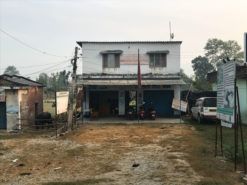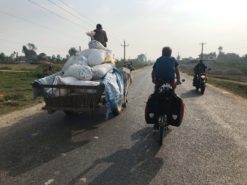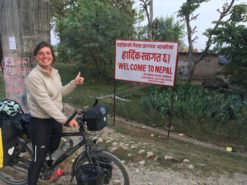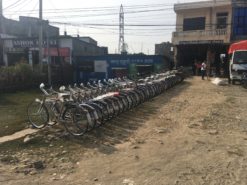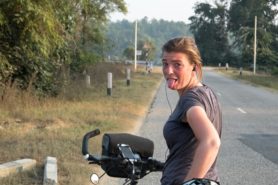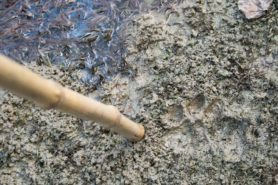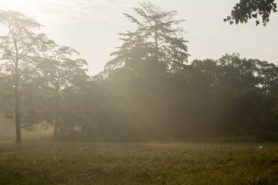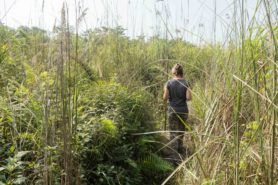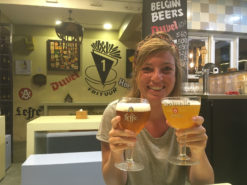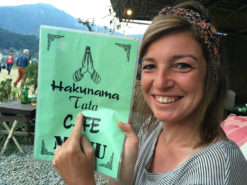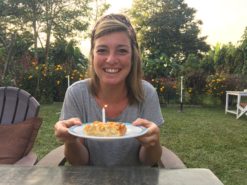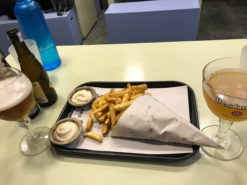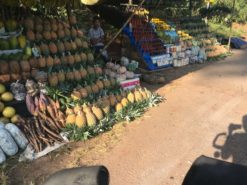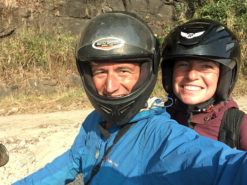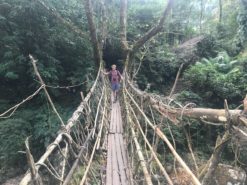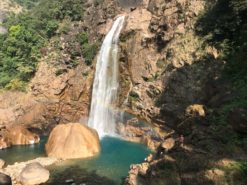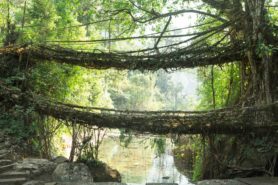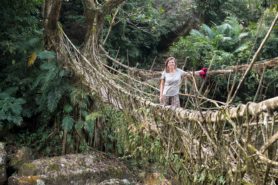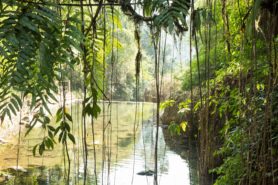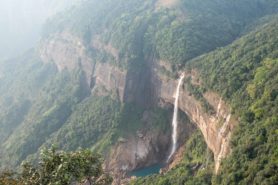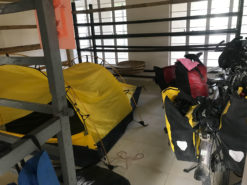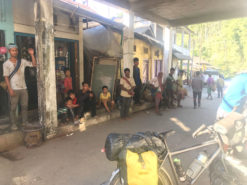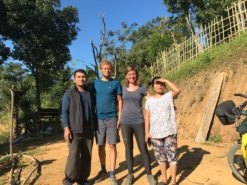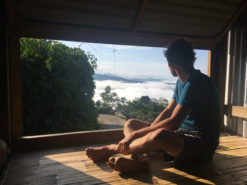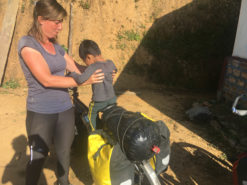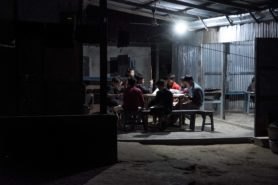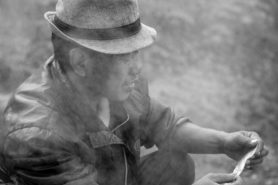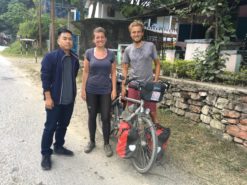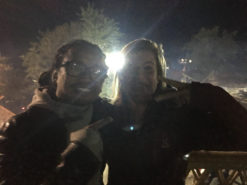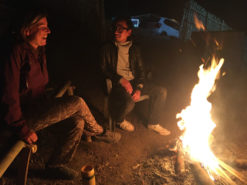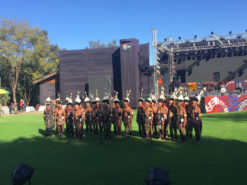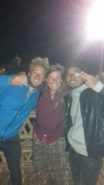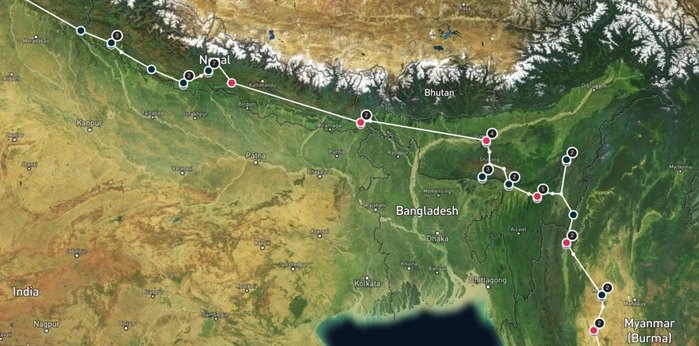Mahendranagar (NP) – Moreh (IN) / 13784 km / 6.7 Million Turns / November 6th – December 8th, 2019
“Back, go back for stamp!”. A man is pointing to a small building that seems to be falling apart. It’s 7 AM and we have just got the exit stamp for India, crossed the border river and entered Nepal. But we have trouble finding the immigration office. Not so strange, it turns out, as this “office” is hidden away from the main gravel road between some water buffaloes and a mud pool. It seems like the immigration office used to be a house and the owner has turned one of the rooms into an office. Conveniently, he also exchanges money for us. Oh, and do we want a tour? He can arrange any for us if we want! If only he had some nice breakfast to serve and it would be complete: the everything-in-one-agency you so often find in these places! The immigration officer/money exchanger/travel agent puts an entry stamp in our passport and welcomes us heartily to his country. Namaste!
Nepal was again a country we had both been before, renown for its high Himalayan peaks, one of the best places to go trekking and to us it had always been connected to Buddhism. This is true for the higher places in the Himalaya, but this time we were about to see a completely different side of the country: the lower, flat, Hindu-inhabited south side. After the hectic cycling in India (see our last blog), we were happy to enter a new country. We noticed the transition in the way people treat us here slowly: every day we cycle further east, the “bye bye” (used as hello) and the smiling became more and the staring and the number of honking drivers became less (the latter is mainly due to a lower number of cars than a change in honking behavior). It eased our somewhat strained bodies and minds and although it was incredibly hot and humid, we enjoyed the cycling here. In the early mornings we shared the road with all the kids who were cycling to school, waving at us enthusiastically. For the first time on this trip we noticed the bicycle as the main means of transportation (at least over short distances). It had another nice advantage for us too: the dogs around here were so used to cyclists that they didn’t bother us at all!
Our first stop in Nepal was Bardia National Park. Here, we hoped to see one of the most majestic and rare animals roaming our planet: the tiger. This national park is the only place where you can do a walking safari in tiger territory, giving you an even closer experience. The most densely tiger populated area is set off purely for this type of safari. Around 70 tigers live inhabit an area of about 1000 square km. Apart from tigers, one has a reasonable chance of spotting wild rhinos, elephants, monkeys, crocodiles and many more wild animals too. We were excited, if not a little anxious when we woke up early morning. We really hoped to spot a tiger here, but we had no clue of what we should do when we actually encountered one. Luckily our guide Baba, who has been working in Bardiya for more than 15 years, armed us. With a stick that was, and one for himself too. No guns or any other weapons. He reassured us by saying tigers generally don’t attack humans. However, he also mentioned that a field worker had been killed by a tiger a few days earlier not too far away and that they were still looking for the tiger who did it. Apparently, once tigers have eaten human flesh, they are relocated to zoos, because they like human flesh and we are quite easy prey for them. Right, we felt totally reassured now! We decided to just stick really close to him the whole day.
It became clear very soon that Baba really knew what he was doing. By locating specific deer barks, a warning sound that tigers are around, he knew what route tigers might be taking and we seemed to be close to one all morning. We spent the day walking from one viewing spot to the next, quietly waiting for more or less an hour at each spot. By the start of afternoon we had spotted a rhino and crocodiles and we had seen fresh tracks of a tiger but no actual tiger. Just when our hopes for spotting a tiger started to sink, Baba heard a barking deer again and led us to another viewing spot. After waiting for nearly an hour at this spot we were rewarded with a tiger crossing a river about a 100m away! With the binoculars we can see him very clearly. It was only for about 20 seconds but felt like minutes, watching the animal slowly pondering through the river. We jumped around from happiness, Baba nearly being the most excited of all three of us. Definitely a day to remember for us!
After Bardiya National park we set aim for Pokhara, where we planned to have a few rest days. Somehow, we really felt we needed a longer pause from cycling to settle our minds a bit. We made a few very long days cycling over the East West Highway (still only a two-lane road), cycling through different national parks, smaller villages and rice paddies. The scenery was nice, but not too interesting. From Butwal we headed up north into the mountains and as soon as we started climbing the scenery got more and more spectacular again. In another two days, we made it to Pokhara, the second biggest city of Nepal. Although touristy, this city had exactly the vibe we were looking for and we ended up staying almost a week. It was a very low-key week, where Tom went paragliding (Sabine’s birthday gift for him), we celebrated Sabine’s birthday, went rafting, ate all types of western food again (Belgian fries, so so good!), drank some nice beers (it was in China where we last had a beer!) and we met up with a few cyclists we had either met before or had been in touch with. Exactly the days we needed to get back our energy to head further east.
Somewhere back in Kyrgyzstan, a few cyclists we had met along the way came up with the idea to spend Christmas and NYE together somewhere in South East Asia together. The idea of a couple of days with 8 cyclists, together in a house, with a pool and a piña colada sounded just too good and from high up in the mountains of Kyrgyzstan, a nice Airbnb in the town of Hua Hin was booked. This did mean however, that once again we had to speed up to make it to Thailand in time for Christmas. Our route would lead us back into the North Eastern part of India, through Myanmar into Thailand, a very long way to go and we only had 6 weeks left to get to Hua Hun. Therefore, from Pokhara we had one last spectacularly scenic day of cycling along the Lower Seti river in Nepal, and we hopped onto a bus to the border of India. Unfortunately sacrifices like those are also part of such a trip, the world is just too big to see it all.
Our feelings about going back into India were mixed. We hoped the traffic would be less hectic and that we could be more in touch with people instead of being stared at and talked about by bystanders. We had read that North East India, also nick-named the seven sisters after the seven states it consists of, is culturally and historically very different from mainland India. People look a lot more like the people in South East Asian, are mostly Christian and the local cuisine is definitely not curries. The region consists of countless tribes, all with different characteristics. All these factors combined made us very curious to explore this secluded part of India.
From the city of Guwahati we started cycling in the direction of Myanmar. Meghalaya was the first state to cross, characterized by being the wettest region of India (12 meters of rainfall per year compared to 0.8 m in the Netherlands), and being matriarchal. This means that woman run the household, pass on their surname and even heredity is passed on mother to eldest daughter instead of son. What we also noticed immediately after leaving Guwahati are the fertile hills! We liked it from the moment we left the big city of Guwahati behind. Fresh tropical fruits as pineapple, mangos and tiny bananas with seeds in them were sold every couple of kilometers. Even the tiniest village had a minimum of 3 churches and what’s more: people suddenly spoke English better than anywhere else in India, so communicating was easy. We later learnt that all the different tribes here have their own language and English is their communal language.
Another thing we learnt was different in this region was the price of hotel rooms. In Shillong the prices skyrocketed (for our budget that is ;)), and none of the 15 cheaper ones we tried would accept us. Suddenly they would all be full even when it was obvious no one was around. Just when we were at the point of giving up on hotels, we ran into Johnny. He was visiting his in-laws and was curious to know what we were doing on our bicycles in this town. Coincidentally, Johnny had stayed at a church a couple of years before and he was still in touch with the caretaker. Within no time he led us to this caretaker and arranged a place to stay for us! Shillong itself was not the most interesting town for us. Our plan here was to rent a scooter and drive up to Cherrapunji, where a couple of very spectacular waterfalls and root bridges are situated. Via the only proper bike shop in town we met Neville, a keen mountain biker himself, who let us stall our bikes at his house for a couple of days.
The next morning we set off on one scooter and made our way to Tyrne, the village close the root bridges. Already on our way we passed many immense waterfalls, some of them nearly a 100m high! Unfortunately, we were there at the driest time of the year and many of them are merely a few drops instead of full blasting falls. But, by the marks and erosion it was easy to imagine how voluminous they are during rainy season. Tyrne was the starting point for a hike towards the root bridges. Built centuries ago, by directing strong roots of trees over rivers and letting them intertwine, these structures grew so solid that multiple people can walk over them and cross rivers. A totally natural bridge that is! Imagine these root bridges being situated in the midst of a dense jungle, with many crystal blue pools around and you get an idea of where we found ourselves! We played around like Mowgli in Jungle book and hiked further up to rainbow waterfall before making our way back to Tyrna and Shillong the next day.
From Shillong we made our way further east. After a few very overpriced, mosquito infested hostels, with loudly snoring neighbors, alarms going off in the middle of the night (Tom even put a phone from an Indian guy, who snoozed for nearly an hour at 3AM, in the fridge after he couldn’t find a way to put the alarm off and the guy was too drunk to wake up himself), we decided to start asking around in villages if people knew a place where we can pitch our tent. We still don’t feel too comfortable wild camping. It turns out to be wonderful experiences. The first person we’d ask would always send us to the headman of the village, who had to give his permission. And so we ended up in a community house one night, in the house of a shopkeeper the next and in a local governmental agriculture office another night. We saw and learned a lot more about the region this way. People seemed genuinely interested in our trip and we never went to bed without being given some kind of food. It was great to be engaged in the conversations again after our previous few weeks in India where we were mostly talked about and not talked to.
It was also in this region that we found out another meaning of a “hostel”. The area was too crowded to pitch our tent just anywhere. As we were looking on google maps we noticed a hostel nearby on the map and we headed there. As soon as we stood in front of the hostel however, we realized this had to be something else. Kids were running around and looking curiously at us, there was no reception, and the building was not finished. The owner of the hostel, Abon, came to meet us, and she quickly clarified what this hostel was: dormitories for kids just outside of the school’s premises, where they stay mostly during the weeks. Sort of comparable with boarding school. Many parents work so hard during the week that the kids stay at these dormitories. Abon takes care of the kids after school, making sure they do their homework, get food and in a way, she raises them. She welcomed us in warmly and let us pitch our tent next to the dormitories. For a while we watched as the kids were doing their homework and studied for their upcoming exams: all around us they are drilling phrases out loud from their schoolbooks. That night we had dinner together and Abon told us all about life in this region. Again, we were surprised how welcoming people are here and how openly they talk with us about their life. It’s one of those very fine advantages of this way of travelling: we get to see and experience so many things from very close by so many times.
Over many winding and hilly roads we continued east towards Imphal. We passed endless tiny villages, each with different tribes. Churches were heard everywhere, and the faces of people here really do look more South East Asian than Indian. Imphal is in the province of Manipur. Up until a few years ago, this region had a lot of unrest and fighting between tribes. Now, as we pass through, there seems to be peace between the tribes and tourism is starting to grow again. The Indian army was omnipresent though. They were friendly to us, but it felt a bit pressing. One night we tried to wild camp on a dead-end trail away from the road, but as soon as we try to set up our tent a woman passes by. She did not speak English, gestured to us that she lived a 100m up the hill from us and invited us over to her house. Unfortunately, the path to her house was too steep to carry our bikes. We tried to explain this to her, a bit insecure if she’d be OK with us camping on her access road. Surprisingly, she picked up a part of our tent and without questioning started to help us put it up. She motioned us again to come up to her house for some food and we take up on the offer heartily. Her brother who also lived there, had worked in Goa for a while and spoke English quite well. Over a few rice wines he told us about his memories of fighting between his tribe in a village just below on the hill and another tribe when he was a kid, and of the killing that happened. He said tourism is what keeps this region peaceful now, as people realize that tourism means money and without peace the tourists will stay away.
In Imphal we decided to leave the bikes again and head north to Kohima in Nagaland. Multiple people on the road had told us about the Hornbill festival that would be taking place here while we were there. This cultural festival is the biggest tribal festival in Nagaland, and for ten days many Naga tribes gather here to perform all kinds of dances, plays and shows. We felt we couldn’t miss the opportunity and so we decided last minute to go there by public transport. We were hosted here by the lovely Yakuza, who himself has cycled in many places in the world – among them also the Netherlands – on a bamboo bike! He even told us about the beautiful town of Boskoop in our home country of the Netherlands, where he met so many nice people. Hilarious how such a random place (Sabine even had to look up where it was as she had never heard of the place) can mean so much to a cyclist passing through!
Yakuza and his friend took us to the festival, and they were the first ones we met who tried to do some expectation management and explain carefully to us that the festival may not really represent how the tribes are living. That it may be a bit of a show and a ‘thing for tourists with big lenses, you know’. We had heard so many great stories though, that we really wanted to see it for ourselves first. We quickly realized they were right though. As we entered there was a tribe performing a play on a field, different tribes were sitting in groups in their traditional clothing together and in between were groups of tourist, indeed with big lenses. These tourists made their way through the crowd, poking the people of different tribes to pose for their camera. We felt as if we were in a zoo and we soon joined Yakuza in the behind the scenes area. Here the ‘real’ Naga people were partying, far away from the fake touristy show at the main venue. He took us around different houses, eating different kinds of foods and it turned out to be one great party in the evening with rice beer in bamboo cups! Slightly hungover we hitch-hiked back to Imphal the next day, sad to say goodbye to Yakuza and his friends so soon. The Christmas clock is ticking however, so we had to move on.
After Imphal it was only two days to the border of Myanmar. We reminisced over the fact that yet again, we had seen such a special part of the world. Such a different face of India! A region most people swiftly pass over on the map, a little unnoticed triangle nestled between mainland India, Myanmar, Bangladesh and Bhutan. Although at first we were a bit hesitant to re-enter India, we were glad we pushed through and got to explore this North-Eastern region. However, we were also very ready to dive into our next region. A big change in culture was waiting for us yet again, transitioning from the Indian Subcontinent to South East Asia. Read all about that in our next blog!
Talk to you soon!
Tom and Sabine


